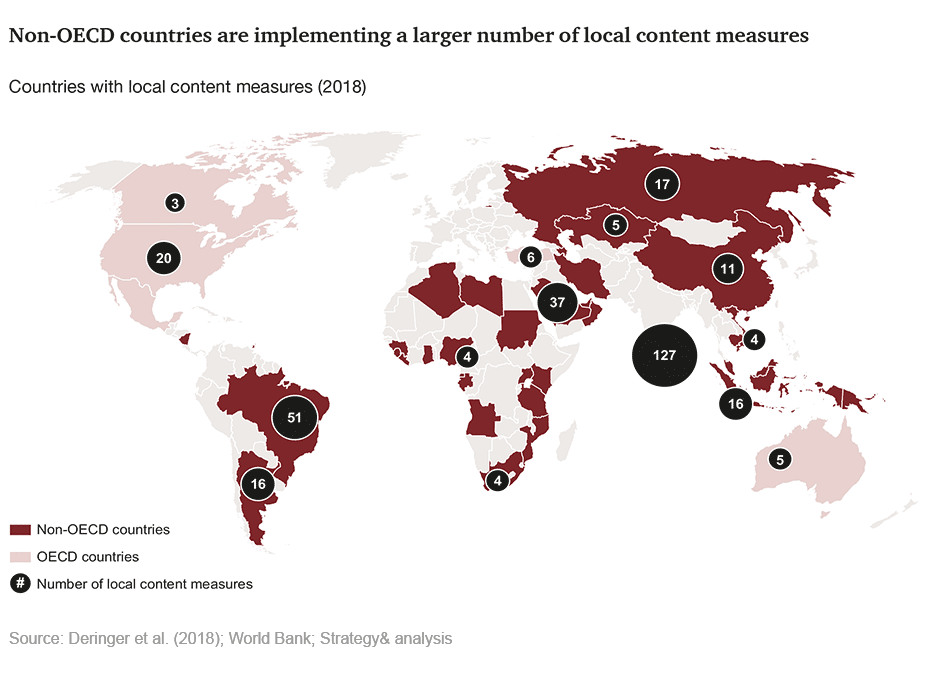The rise of local content development policies
Governments in developing economies are increasingly crafting policies to expand the share of local goods and services in large infrastructure projects worth trillions of dollars. Doing so can boost growth, create jobs, and support national economic strategies. The countries that are the keenest on local content development are also those spending the most on infrastructure. Between 2008 and 2017, countries from outside the Organisation for Economic Co-operation and Development (OECD) spent US$13 trillion on critical infrastructure, compared to $9 trillion for OECD countries. In the coming 20 years, this gap will widen, with non-OECD states projected to spend more than $57 trillion on infrastructure projects, compared to $34 trillion by OECD countries.

Illusions, biases, and distortions
Many governments have a sense of urgency that, although commendable, can lead to short-sighted and counterproductive policies. Specifically, there are biases that can interfere with robust, fact-based analysis and policy design. With regard to local content development policymaking, there are three deeply rooted illusions.
1 - Confirmation bias
False aggregation of demand
Confirmation bias, the overweighting of evidence consistent with a favored belief, manifests itself in local content development policies as a persistent tendency to overestimate the localization potential of certain products. Usually this is due to vague categorization that leads to a lack of specifics and detail. For example, a strategy may identify products like pumps, motors, or valves as categories in which aggregating demand across several state-owned enterprises offers significant opportunities for localization. Such an approach neglects the reality that even the simplest of products can exhibit a significant diversity of sizes, materials, and designs. A valve, for example, could be anything from a quarter-inch plastic turn valve to a large-diameter, nickel-chromium, double-flange butterfly valve. One sells for pennies whereas the other requires precise engineering and can cost tens of thousands of dollars. Grouping two such disparate objects into the same category creates the illusion of a large market opportunity where none exists.
2 - Salience bias
Fixation on familiar objects
Salience bias, the tendency to focus on familiar concepts, often draws the attention of policymakers to more recognizable end-products like solar panels, wind turbines, automobiles, and household appliances. Fundamental base industries, unfamiliar intermediate products, and obscure sub-components are often overlooked. For example, several countries favor domestically assembled end products like solar panels by exempting the imported sub-components (e.g., solar modules) from duties. Paradoxically, such a policy inadvertently disadvantages domestic manufacturing of products further up the value chain, such as solar cells. The evaluation of localization policy success should be measured in terms of incremental value creation, not eye-catching trophies.
3 - Optimism bias
Absolutist target-setting
Optimism bias — a partiality for positive expectations divorced of context and freed from nuance — often colors the lens through which policymakers view local target setting. Some government administrators may consider higher percentages of local content more desirable without a clear understanding of whether they create economic value. Imposing local content requirements creates value for the national economy up to a certain threshold. Thereafter, requirements may actually destroy value. The percentage of economically beneficial local content could increase with time as the capabilities of the domestic industrial supply chain progress, but it will naturally stop short of 100 percent. Some inputs will always prove cheaper to import than to build locally.
Removing biases from local content development policies
Policymakers should ask if their decision-making processes have sufficient mechanisms to check and correct for biases and blind spots. Based on our experience, a set of safeguards can improve the quality of such decisions and the underlying analysis. These fall into two categories, behavioral and analytical, which complement and reinforce each other (see Exhibit).

Conclusion
The right local content policies can help developing economies capitalize on the trillions of dollars they will spend on infrastructure projects over the next two decades. However, good intentions are not enough. Policymakers must understand the biases that cloud their analyses and decision making. Armed with a greater awareness of such biases, government entities can dramatically improve the quality of their analysis and the effectiveness of local content development policies. Only by changing the way they think will they be able to ensure that their economies benefit.
Contact us




















Menu